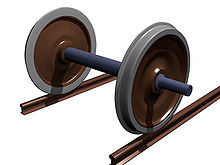Rail guide
A rail guide is understood to be a guide system with guide rails. There are two types of construction:
- The first design is a guide system in which one or more guide carriages run on one or more fixed, long, mostly straight bodies (the rails). In the case of horizontal movements, the rails are usually arranged in pairs next to each other and under the load, whereby the rail and carriage are usually mounted so that they can be moved one on top of the other (like an upper and lower part), but are also fastened vertically (e.g. on the side wall of a component) can.
- The second design involves rail guides with two rails that can be moved relative to one another, one of which is mounted on or on the moving part itself.
Applications for rail guides are primarily rail vehicle technology and linear technology, where linear guides are also used.
Differentiation from wave guides
Rail guides always have guide elements and a specific guide profile, whereby guides with a round guide profile (wave profile) do not count as rail guides. These are commonly referred to as wave guides .
Types of rail guides in mechanical engineering
Although rail guides with only one rail could commonly be referred to as monorail guides, this designation is unusual in mechanical engineering . Instead, guides in linear technology with a profile rail and one or more carriages, which usually have two or four ball or roller circuits, are usually referred to as profile rail guides .
If fixed track rollers are used instead of the ball or roller circuit , the corresponding rail guide is called a track roller guide . Roller guides can be designed in such a way that, in addition to a linear stroke , curves guided by the rail can also be driven.
Profiled rails and rollers as well as their guide carriages are connected to the components to be guided against each other by means of several screws arranged at regular intervals .
Linear designs with several rails can be implemented on the one hand by the parallel arrangement of at least two profile rails, telescopic rails or roller guides , on the other hand by so-called cage rail guides , in which the rolling elements are arranged between two rails that are screwed multiple times.
Furthermore, a distinction is made between Gleitschienenführungen (Rail guides with sliding) and Wälzschienenführungen in which similar roller bearings or linear bearings separating rolling elements, the friction between the various elements or components of the guide to reduce, and thus the movement greatly facilitate the to-carrying components.
Rail guides for rail vehicles
Types of rail guides in rail vehicle technology are u. a. the Translohr rail guide and the TVR rail guide for track buses.
- Rail guides for track buses
Rail guides in motor vehicles
In motor vehicles , rail guides are used to guide and fasten (by means of integrated locking ) of seats in motor vehicle equipment .






